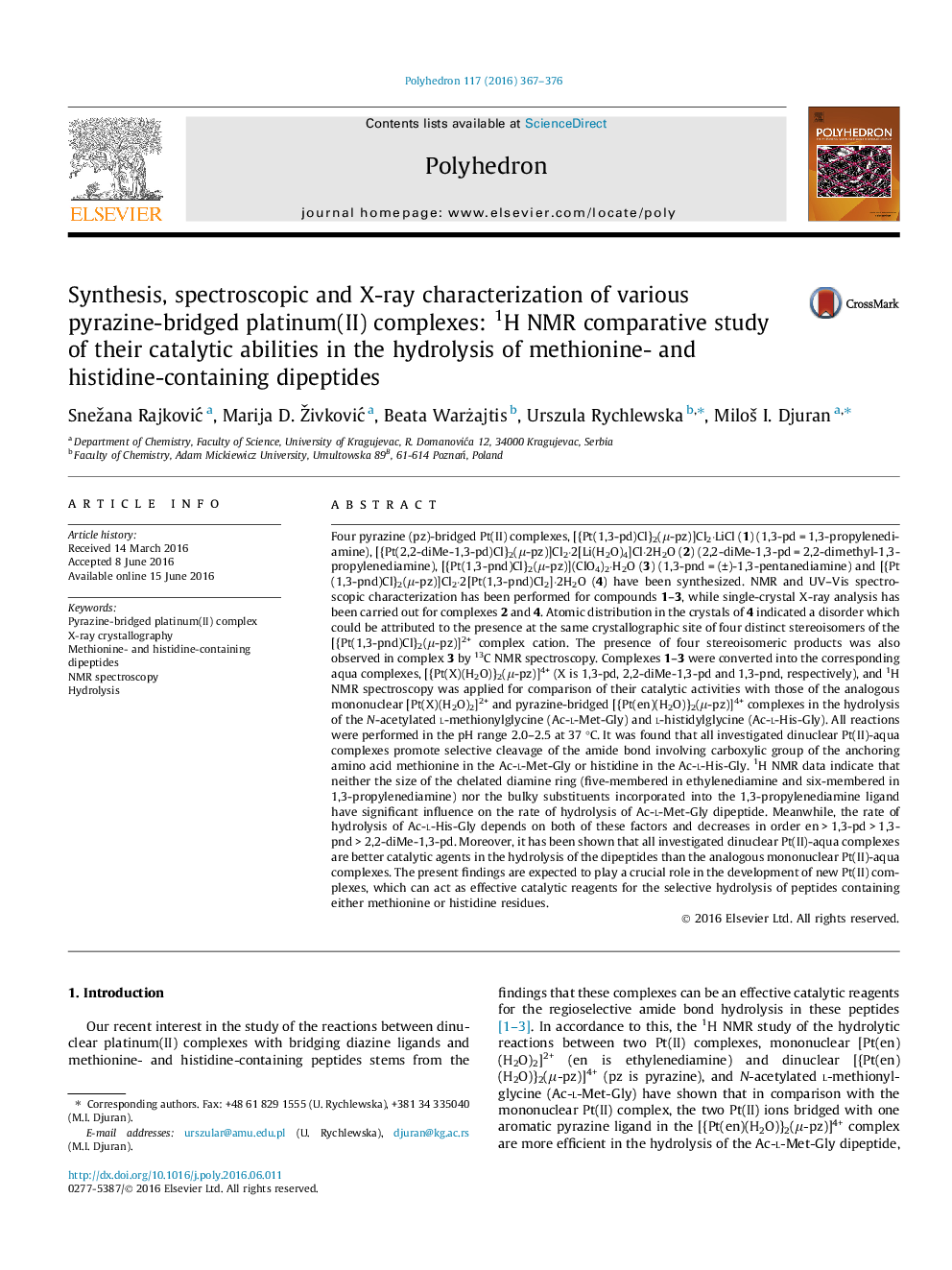| کد مقاله | کد نشریه | سال انتشار | مقاله انگلیسی | نسخه تمام متن |
|---|---|---|---|---|
| 1336217 | 1500223 | 2016 | 10 صفحه PDF | دانلود رایگان |

Four pyrazine (pz)-bridged Pt(II) complexes, [{Pt(1,3-pd)Cl}2(μ-pz)]Cl2·LiCl (1) (1,3-pd = 1,3-propylenediamine), [{Pt(2,2-diMe-1,3-pd)Cl}2(μ-pz)]Cl2·2[Li(H2O)4]Cl·2H2O (2) (2,2-diMe-1,3-pd = 2,2-dimethyl-1,3-propylenediamine), [{Pt(1,3-pnd)Cl}2(μ-pz)](ClO4)2·H2O (3) (1,3-pnd = (±)-1,3-pentanediamine) and [{Pt(1,3-pnd)Cl}2(μ-pz)]Cl2·2[Pt(1,3-pnd)Cl2]·2H2O (4) have been synthesized. NMR and UV–Vis spectroscopic characterization has been performed for compounds 1–3, while single-crystal X-ray analysis has been carried out for complexes 2 and 4. Atomic distribution in the crystals of 4 indicated a disorder which could be attributed to the presence at the same crystallographic site of four distinct stereoisomers of the [{Pt(1,3-pnd)Cl}2(μ-pz)]2+ complex cation. The presence of four stereoisomeric products was also observed in complex 3 by 13C NMR spectroscopy. Complexes 1–3 were converted into the corresponding aqua complexes, [{Pt(X)(H2O)}2(μ-pz)]4+ (X is 1,3-pd, 2,2-diMe-1,3-pd and 1,3-pnd, respectively), and 1H NMR spectroscopy was applied for comparison of their catalytic activities with those of the analogous mononuclear [Pt(X)(H2O)2]2+ and pyrazine-bridged [{Pt(en)(H2O)}2(μ-pz)]4+ complexes in the hydrolysis of the N-acetylated l-methionylglycine (Ac-l-Met-Gly) and l-histidylglycine (Ac-l-His-Gly). All reactions were performed in the pH range 2.0–2.5 at 37 °C. It was found that all investigated dinuclear Pt(II)-aqua complexes promote selective cleavage of the amide bond involving carboxylic group of the anchoring amino acid methionine in the Ac-l-Met-Gly or histidine in the Ac-l-His-Gly. 1H NMR data indicate that neither the size of the chelated diamine ring (five-membered in ethylenediamine and six-membered in 1,3-propylenediamine) nor the bulky substituents incorporated into the 1,3-propylenediamine ligand have significant influence on the rate of hydrolysis of Ac-l-Met-Gly dipeptide. Meanwhile, the rate of hydrolysis of Ac-l-His-Gly depends on both of these factors and decreases in order en > 1,3-pd > 1,3-pnd > 2,2-diMe-1,3-pd. Moreover, it has been shown that all investigated dinuclear Pt(II)-aqua complexes are better catalytic agents in the hydrolysis of the dipeptides than the analogous mononuclear Pt(II)-aqua complexes. The present findings are expected to play a crucial role in the development of new Pt(II) complexes, which can act as effective catalytic reagents for the selective hydrolysis of peptides containing either methionine or histidine residues.
Although all investigated dinuclear Pt(II)-aqua complexes promote selective cleavage of amide bond in the N-acetylated Ac-l-Met-Gly and Ac-l-His-Gly dipeptides, the marked dependence of this process on the size of the diamine ring and the bulk of its substituents is only observed in the hydrolysis of the Ac-l-His-Gly dipeptide. Valid for both dipeptides is the finding that dinuclear Pt(II)-aqua complexes are better catalytic agents than the analogous mononuclear Pt(II)-aqua complexes.Figure optionsDownload as PowerPoint slide
Journal: Polyhedron - Volume 117, 15 October 2016, Pages 367–376